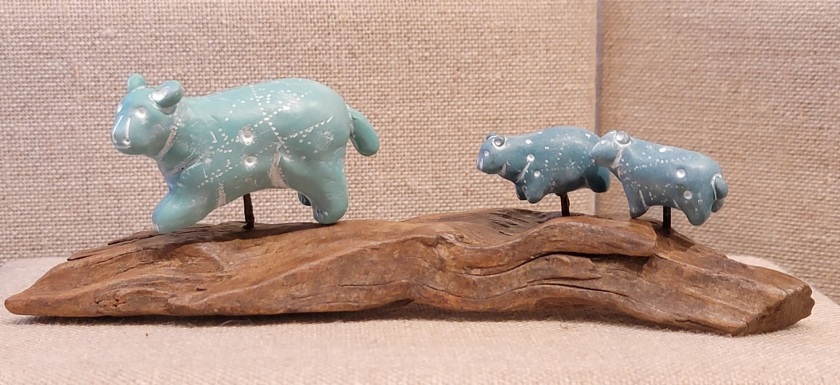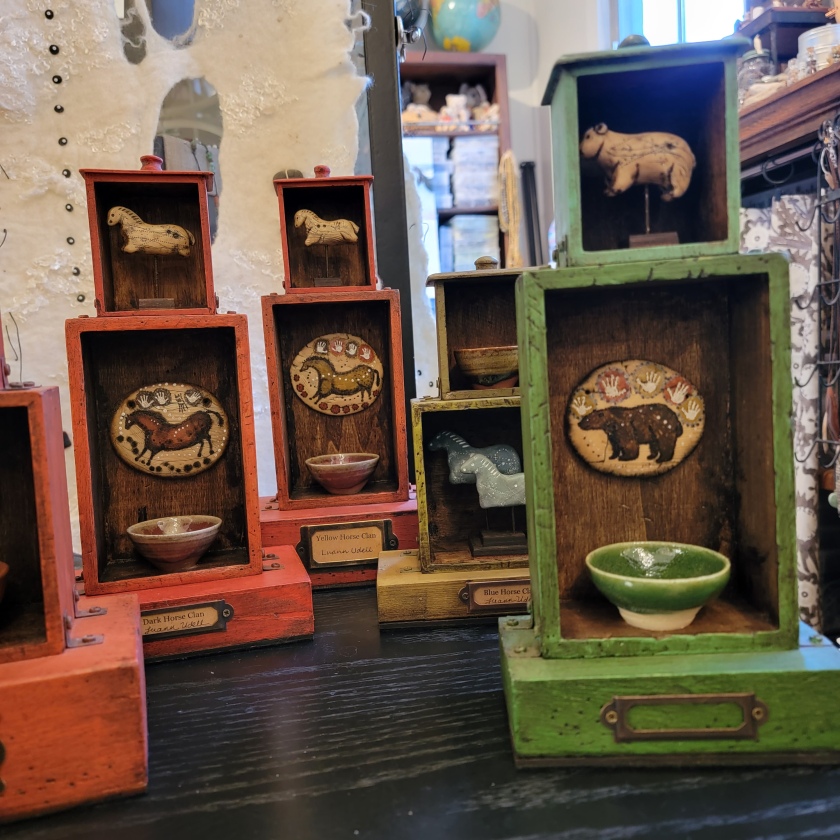Myth: If only I could get into X Gallery/get Famous Person Y to see my work/get a website, I would be successful!
Reality: No one person, event or venue will make or break your vision.
When I first started showing and selling my art, I read these very wise words somewhere:
Every day you will find an opportunity to move your art/biz forward. Every day you will overlook an opportunity to move your art/biz forward.
I quote them now because a reader posted this comment on my blog recently, and with her permission, I reprint it here:
Hello, again! I get what you’re saying, Luann, I really do. But right now I’m really in a down space.
Filled with excitement, I opened up a space in Etsy back in September thinking that *there* I would find people who would see value in handspun hand-dyed yarn. They do, apparently–there are lots of other spinners on Etsy–but evidently they don’t see any value in mine.
Lots of looks, a few hearts, no sales.
One part of me is bugging me to get busy and make more yarn, but the other part of me is saying, “Why make MORE beautiful yarn that no one will want to buy? What’s the point of doing that, when no one wants what I’ve already made?”
I’m sorry for dumping on you my own pity-party, but I need someone who is an artist and “gets it” to vent to. ..
Maybe the Lord is trying to tell me to give up and become a boring housewife who grades papers and washes dishes and remembers when she used to make beautiful stuff. I don’t know.
Dear Reader, I give you permission to wallow for awhile. Things do get hard, and we all get discouraged. (See Myth #14 about this.) (Not yet, I haven’t written it yet!!)
But I can assure you wholeheartedly that the Lord is not telling you to stay small and regret your lost dreams. 🙂
Sometimes we take that leap and many things fall into place. Sometimes we take that leap–and things stay hard.
In fact, that is the major purpose of my blog: To chronicle my journey pursuing my art, with honestly and self-examination. And hopefully, a huge helping of inspiration.
Because, as my husband pointed out to me a short while ago, we always hear about the instant overnight successes. (What I call the Cinderella stories.) And we also hear about the not-so-overnight success stories, where the hero struggles and perseveres, and finally gets a lucky break.
The point is, we already know how those stories end. We know the goal was achieved, because the tales are always told afterwards–not while the ball is actually in play.
My blog is all about the ball being in play. And sharing that process with you.
So here are some possible scenarios regarding this handspun yarn biz, but don’t take the “you” thing personally. These are just some things to think about:
1. When we stand at the beginning of our stories, we cannot see the end.
Sometimes, we can’t even see what our ultimate goal will be. Longtime readers may remember my sad little story about wishing my handknit toy sheep idea taking off.
And when they finally did, how I discovered how much I hated knitting toy sheep.
If your handspun biz where to be an instant hit, you could be locked into a business that takes too much time away from your other pursuits right now. Or you might find spinning is fun for a few hours a day, but not so much fun doing it all day. Maybe you’ll realize you like writing about the process, or teaching the process, more than making yarn to sell. (Although that piece of it will give you the insights you need to do the other stuff–writing, teaching, demonstrating, etc.) Maybe you’ll end up developing a therapy program with your skills. Who knows what the possibilities are?
So maybe right now you think your dream is to sell handspun yarn. But maybe even bigger things are in store for you.
2. We cannot tell what strategy will work, and which ones will peter out.
Etsy looks like a “sure thing” from the outside, but having an Etsy shop does not guarantee success.
We dream of getting into “that great gallery”, sure we will be successful if they would only represent our work. We dream of finding “the perfect show” where we will find all the buying customers we need. We know if only we had a great website, we would be flooded with orders.
In reality, there is no “perfect venue” or “perfect strategy”. There is simply another opportunity to try.
Maybe e-commerce will work for you. Or maybe your yarns would sell better “in person”–at small local shows, or certain events. (We have a big “Wool Tour” here in New Hampshire on Columbus Day weekend. People come from hundreds of miles to tour small farms, see llamas and sheep and angora goats and bunnies, and buy fleece, roving and finished yarns.) Maybe people need to touch your yarn to fully appreciate it first, and then you turn those customers into online customers with reorders.
Maybe a “new product release” about your yarns to a knitting or spinning magazine would bring interested buyers to your Etsy store.
3. We may be trying to sell to the wrong people.
Etsy is the biggest and best-known venue for handcraft. But it’s also a huge venue for vintage goods and craft supplies. And it’s a big shopping venue for other artists. So you may be inadvertently trying to sell to people who can make it themselves.
At a friend’s suggestion, I used Etsy as a way to sell to my current customers. I didn’t actually think I could join an already established, close-knit online community (no pun intended) and create a strong presence there.
Even so, I didn’t have a single sale on Etsy. I’m exploring other ways to sell online, and will use Etsy to offload my old supplies.
4. It just may take more time than you think.
Another reader posted a reply to the original comment, and it’s a good one. (In fact, I just realized I’ve repeated a lot of what Kerin said!! oops…)
And see item #1 above, where things taking time can be a good thing.
5. And sometimes it’s just hard.
It’s true–it’s just hard sometimes. There are days when we just feel like the universe is saying “no”.
But what does your heart say?
Because if you give up, there is only one thing that can happen: Nothing!
If you persevere, anything can happen. Including failure, but failure is not necessarily a bad thing. (Go back to the knitted sheep thing.)
#5: What is “success”, anyway? What does it mean to Y*O*U?
Right now you haven’t had any sales. Is that your only measure of success?
Have you learned how to spin and dye beautiful yarn? You’ve successfully developed a product.
Have you learned how to photograph it? Have you successfully uploaded images to a website? You’ve successfully done something millions of people have no idea how to do. (Since I lost my photographer, I’ve had to work on developing a whole nother skill set, and that learning curve is steep!)
Have you learned how to talk about it, write about it? You’ve learned how to pitch your product.
And have you learned how to create a unique product? Which leads us to….
#6. Are you telling your real story?
Sometimes, especially when we first start out making stuff and getting it out into the world, we focus on the surface of the process. When you hear artists say, “I just love color!” or “I just love knitting!”, we are listening to someone who has either a) not bothered to dig deeper; b) doesn’t know how to dig deeper; or c) or is afraid to dig deeper.
What is it about hand-spinning and dyeing that excites you? What does it mean to you? Don’t say, “Oh, it’s fun” or “Oh, it’s relaxing.”
Tell us why.
Here’s a perfect little example that Bruce Baker tells in his seminars.
A potter makes tiny little pots with lids, very charming. But so what?
She explains that her life is so hectic, so harried, that when she takes time to make these tiny wonders, she envisions she is creating a little moment of serenity, of quiet. “And then she draws up the tops, and makes a little lid, and there is a little moment of time preserved….”
Doesn’t that make you want to own one of her little pots? And when you are harried and frazzled, you can lift the tiny lid….and there is your own little moment of quiet and peace.
She told us the “why”. And when you purchase her product, you can have a little of the “why”, too.
7. If it brings you joy, you should not–cannot–stop doing it.
It’s hard when it feels like the world does not want our beautiful work. But remember when I said, “I have to do it anyway, or I’ll die?” That’s what got me through.
Yeah, I know I wouldn’t drop dead if I never made another little horse. But I know something inside me would wither away. And the world, whether it knew about the loss or not, would simply be a sadder place for it.
I want to believe in my heart that somehow, in ways I may not see or could even possibly imagine, that the world is a better place for me making my work. For me being in the world. I have to believe that. Because to believe otherwise is to give in to self-doubt, and eventually, despair.
And whatever we believe in, whatever our religion or creed or ethics, if we are creative people, then we have to believe that creativity makes the world a better place. That anything we make–a lovely skein of yarn, a useful pot, an inspiration movie, a beautiful song, a warm and loving home for those we care about–the world is a better place for that.
Or what are we here for?
So keep making your yarn, because it makes you happy. Don’t give up, but be open to where it leads you (because it may not take you where you think you’re going!) Take the opportunities you find. Let go of the ones you miss, and move on. Think about the deep “why?”, and don’t be afraid to share it.
And know that whatever happens, it’s all good.











